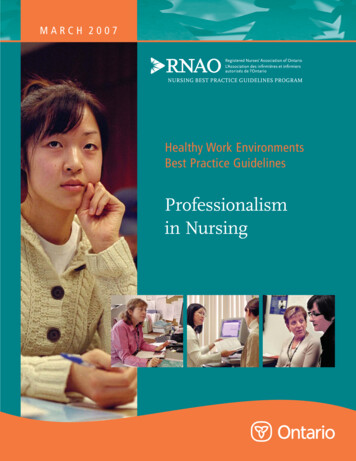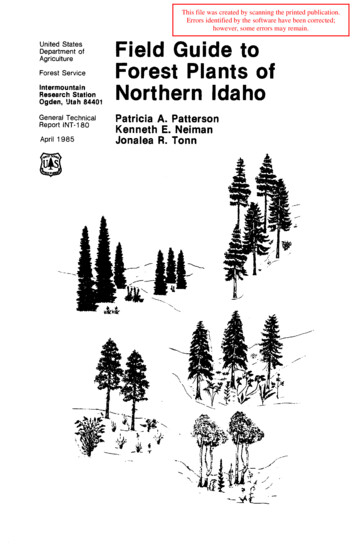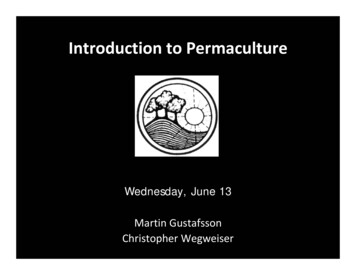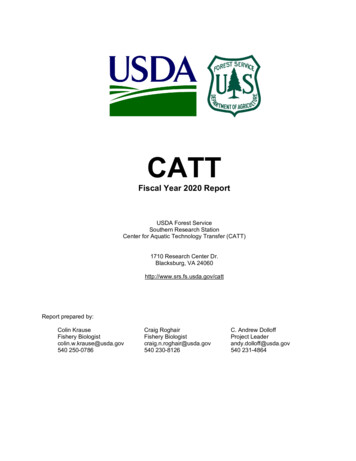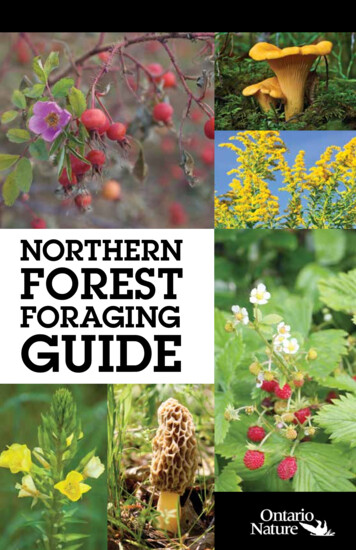
Transcription
NORTHERNFORESTFORAGINGGUIDE
Northern Forest Foraging GuideIdeally, people will become exceptionalstewards of Ontario’s natural areas.Sustainable harvesting methodsrelating to trees, shrubs, plants andfungi vary, so in some cases additionalresearch may be required to ensuresustainability. The timing of harvestingis also important, as some parts ofa plant (such as flowers or fruit) arenot available year-round, while others(such as tree needles) are. Not takingmore than is needed at one time is alsoimportant, as taking too much reducesavailable resources for other users andcontributes to increased waste of theseresources. Harvesting too much canalso impact a species’ ability to growand reproduce.Vladimir Melnikov/Essentials Collection/Getty Images International Although foraging for edible plantsis permitted on most public landin Ontario, obtain permission fromthe owner before collecting plantson private property. Another bestpractice is to obtain permissionfrom the local First Nationcommunity before harvestingon traditional territory. Management goals vary for protectedareas and nature reserves. Ensurethat wild food foraging is permitted inthese areas before harvesting.The trees, shrubs, herbaceous plants and fungi listed in this guide are asample of some of the abundant local species that can be harvestedsustainably in Northern Ontario, though there are many other wild edibles toexplore. The guide is intended to be a starting point for people interested inforaging for edible wild plants and should not be considered to be a definitiveresource for their identification and use.Basic Rules for HarvestingEdible Wild Plants and FungiHarvesting edible wild plants can bea fun, educational and sustainableactivity for all ages if it is doneproperly. Ontario Nature has identifiedsome basic rules for harvestingwild plants to ensure the safety ofparticipants and the sustainabilityof plants involved.can positively identify as edible.Learning about plants from a localexpert, consulting books andtaking courses or workshops arerecommended (see the resourcesat the end of this guide). Harvest plants in areas where youknow the risk of contamination fromindustrial and other pollution is low. Eat only a small quantity of any plantyou have not eaten before and assesshow it affects you before eating more. Be sure you know what you areharvesting, and eat only plants youTREESSHRUBS2 Most importantly, take only whatyou can use and use what you take.Edible wild plants are a sharedresource. Users of them must takeresponsibility for ensuring that theywill continue to thrive year after year.Sustainable HarvestingImproper harvesting techniques andoverharvesting can have a significantnegative impact on the ability of aspecies to reproduce. This practice canlead to the disappearance of a speciesfrom an area and the loss of a localfood source, affecting both humansand other species. A general rule is tocollect only 5 percent of any individualpatch of a given species within amaximum of 25 percent of an area.Following this guideline helps ensurethat the plants are able to reproduce.For plants that have a long life cycleand take many years to grow tomaturity, sustainable harvesting entailspicking even less.Kendal DonahueOntario’s forests, meadows and waters provide an incredible range of nutritiousand delicious edible wild plants. Ontario Nature has prepared this foraging guideas an introduction to this local resource, and to encourage people to get outsideand experience the wonders the natural world provides.Practicing sustainable methods ofharvesting the species listed in thisguide is crucial to minimizing humanimpact on them and other species thatrely on them. Such methods contributeto increased food security andindependence, which are particularlyHERBACEOUS PLANTSFUNGI3
TREESCedar Thuja spp.important in communities wherehealthy foods are not always availableor easy to obtain.species. Be extremely cautious aboutlook-alike and poisonous species.IDENTIFICATIONUSES & RELATED INFORMATION Tea made from the leaves is said tosoothe the throat, and tea made fromthe bark is said to aid kidney function Large conifer tree with rough, crumbly bark Leaves scaly and very fragrantCaution!If you are uncertain about theidentification of a species, beforeconsuming it consult additionalfield guides and expert sources toconfirm what it is. Experts suggestthat if you have not eaten a plantbefore, try only a small sample of it;people’s responses to even knownedible species may vary. When youuse a plant for the first time, allergicreactions or other sensitivities mayoccur; if they do, consult a medicalprofessional. Aboriginal peoples havetraditional medicinal uses for someof the plants mentioned in this guide,and many of these uses have beenincluded in the text. Consult a medicalprofessional or expert Indigenousknowledge holder before using anyplant for medicinal purposes. Soaking in bath water containing cedarleaves is said to soothe rashes, skinirritation and shinglesLOCATIONAmber DeGrace CC BY 2.0 Moist areas in forests and swamps ornear waterHARVESTING TIME Year-roundCAUTIONSTREESSHRUBS4 Consume only a small quantity, becausecedar leaves release small amountsof toxinsdavelogan/Signature Collection/Getty ImagesAcknowledgmentsOntario Nature would like toacknowledge all of the expertsconsulted during the preparation ofthis guide. They are listed at the backof the guide, along with otherresources. Additionally, the guideincludes Aboriginal knowledgeabout using and preparing plants,and Ontario Nature thanks Indigenousknowledge holders for their sharingand contribution.DisclaimerOntario Nature takes no responsibilitywhatsoever for any adverse healtheffects due to the consumption orother use of any plant described in thisguide. It is intended to provide generalinformation only. Check with yourhealthcare provider before using wildplants to treat any medical condition.Before consuming any wild plants, youshould be absolutely certain of theiridentification. Seek expert advice anduse at least two reputable field guidesto confirm the identification of a Cedar oil can be produced by putting thecedar buds/tips in a jar with olive oil andletting it sit, sealed, for 4-6 weeks. Somepeople use this oil to treat warts and coldsores, and as a natural insect repellantHERBACEOUS PLANTSFUNGI5
TREESJack Pine Pinus banksianaIDENTIFICATIONPaper Birch Betula papyriferaUSES & RELATED INFORMATION Some people use the needles to preparetea high in vitamin C (honey or cinnamonmay be added to mask the bitter taste) Short needles in clusters of two that arenot twisted together Cones closed and tight to the branches Some people chew the raw pitch to treatsore throatsLOCATION Some people warm the sap and applyit externally as a salve which is said torelieve joint and muscle pain, swelling,bites, burns and irritations Throughout boreal forest, but also insome open areasHARVESTING TIMECAUTIONS Year-roundIDENTIFICATIONUSES & RELATED INFORMATION Sap can be boiled to reduce it to a syrup,which has half the sugar of maple syrupand is more savoury (tastes similar to soysauce or Worcestershire sauce) Older bark white and papery, youngerbark smooth Triangular leaves with toothed margins Inner bark can be added to soups andstews or dried and powdered to use asa flourLOCATION Sunny, moist areas Catkins and leaves can be added raw tosalads or cooked in vegetable side dishesHARVESTING TIME Spring to fall Tea can be made from the twigs and leavesCAUTIONS Do not eat this plant if you are pregnant(can cause miscarriage)Allie KF CC BY-SA 2.0nikamata/Signature Collection/Getty Images Harvest the inner bark only from recentlydowned branches or small branchesclipped from the main tree to minimize theimpact on overall tree health and growthTREESSHRUBS6HERBACEOUS PLANTSFUNGI7
SHRUBSCranberryCommon Red Raspberry Rubus idaeusVaccinium oxycoccos and macrocarponIDENTIFICATIONUSES & RELATED INFORMATION Berries can be eaten raw or processedinto jams or jellies, juices, sauces or teas Mostly under 20 cm in height Flowers pink, berries red/purple Berries can also be added to both sweetand savoury foods, such as pies, muffins,soups, stews and saladsLOCATION Wet areas and near bogs, ponds and lakes The health benefits of cranberries are saidto include reduced risk of the formationof kidney stones, and relief from bladderinfections, cramps and nauseaHARVESTING TIME September to November (best afterfirst frost) Tannins in the cranberries are said toimprove heart health and reduce bothtooth decay and the formation of plaqueon teethIDENTIFICATIONUSES & RELATED INFORMATION Berries can be eaten raw, made into jams,jellies, or juices or added to desserts Up to 2 m in height Prickly spreading stems, becomingsmoother with age Alternate compound leaves on pricklystalks, usually three to five leaflets per leaf Flowers white/green Young, peeled stems are edible in bothraw or cooked preparations Some people boil the leaves into a tea totreat diarrhea and crampsLOCATIONCAUTIONS Do not consume wilted leaves, which canbe toxic Moist, temperate regionsHARVESTING TIME SummerCAUTIONSMako CC BY 2.0Avalon Studio/Signature Collection/Getty Images Consume only in moderation to avoidpossible irritation of stomachTREESSHRUBS8HERBACEOUS PLANTSFUNGI9
SHRUBSNorthern Bush-HoneysucklePrickly Rose Rosa acicularisDiervilla loniceraIDENTIFICATIONHARVESTING TIME 1 m or less in height Leaves usually oval but pointed at end(edges tend to curl inwards) Flowers yellow for most of the season,turning orange by late summer June to JulyUSES & RELATED INFORMATION Infusions made from the bark and stemsare said to flush toxins from the body andimprove kidney healthLOCATION This plant was used in traditionalAboriginal medicine, though this use isnot common today Sunny to moderately shady wet or dryareas, edge habitatIDENTIFICATIONUSES & RELATED INFORMATION Raw petals can be added to salads,teas and jellies and are said to sootheheadaches, mouth sores and indigestion Up to 1.5 m in height with prickly stemsand branches Red hips (fruit) usually 1 to 2 cm in length,flowers pink Buds, young shoots and leaves canbe eaten raw or sautéed with othervegetablesLOCATION Rose hips are high in vitamins andnutrients and can be dried and boiledin teas, or preserved in jams or jellies(though this can be very time-consumingdue to their small size and the largenumber required to make a small tomedium sized batch of jam) Open woods, thickets, rocky slopesHARVESTING TIME Spring to winter Three rosehips are said to contain thesame amount of vitamin C as one orangeCAUTIONSMalcolm Manners CC BY 2.0Homer Edward Price CC BY-SA 2.0 Use only whole rosehips or their fleshyoutside layer, as the seeds can causeintestinal discomfortTREESSHRUBS10HERBACEOUS PLANTSFUNGI11
SHRUBSHERBACEOUS PLANTSBluebead Lily (Clinton Lily)Willow Salix spp.Clintonia borealisIDENTIFICATIONUSES & RELATED INFORMATION Shoots are watery in taste and texture,and can be used similarly to cucumber Can exceed 10 m in height, dependingon species Four buds completely encircling the stem Flower shape, size and colour variable,depending on species Catkins can be cooked with othervegetables or added to soups for a boostof vitamin C Bark contains salicin (similar to Aspirin, oracetylsalicylic acid) and can be chewed ormade into a tea that is said to relieve pain,inflammation and digestive problemsLOCATION Variable depending on species, butusually moist areas or near water Leaves and twigs can be boiled to make arinse that is said to increase the shininessof hair and reduce dandruffHARVESTING TIME Spring to summer (bark and catkins bestin spring, leaves best in summer)IDENTIFICATIONUSES & RELATED INFORMATION Leaves can be eaten raw or cooked andtaste similar to cucumber Up to 40 cm in height Large leaves with parallel veins andsmooth margins Yellow-green flowers and blue berries onlong stalks A poultice made from the leaves can beused on wounds and bruises and is saidto prevent infection and promote healingCAUTIONSLOCATION Do not eat the berries, which are toxic Forests with open understoreyHARVESTING TIME SpringCAUTIONSCharles de Milles-Isles CC BY 2.0AlinaMD/Essentials Collection/Getty Images Do not consume willow if you have aknown sensitivity to AspirinTREESSHRUBS12HERBACEOUS PLANTSFUNGI13
HERBACEOUS PLANTSBurdock Arctium spp.IDENTIFICATIONCattail Typha spp.USES & RELATED INFORMATION 0.5 to 1.5 m in height (on average, will varyby species) Pink/purple flowers with large burrs Heart-shaped hairy green leaves with softwhite undersidesLOCATION Roadsides, disturbed areas Young leaves (picked in spring or earlysummer) can be added raw to salads,cooked in soups and stews, or boiled(one or two changes of water may beneeded to reduce the bitter quality ofthe leaves) 1 to 3 m in height Leaves long, slender and stiff Flowers forming tight cylindrical clusters Peeled roots can be boiled, stir-friedor pickled Marshes, lakes, and streams withcalm waters M edicinal teas made from the leavesare thought to help purify the blood andimprove liver and kidney functionHARVESTING TIME August to OctoberIDENTIFICATIONCAUTIONSUSES & RELATED INFORMATION The core of the stem tastes similar tocucumber and can be eaten raw, boiled,sautéed or fried When green, flower heads can besteamed or roasted once the stalk andpapery outer layer are removedLOCATION The pollen can be collected by shakingthe flower head into a bag and then siftingthe contents to separate out the pollen,and can be used in both savoury andsweet recipesHARVESTING TIME Spring for flowers and pollen, fall to earlyspring for roots and shootsCAUTIONS D o not consume if you are pregnant (cancause spotting or miscarriage) or diabetic(can affect blood sugar levels) Ensure that you have correctly identifiedthis plant before eating it, because youngcattails may be mistaken for some wildmembers of the Iris family, which arepoisonous Avoid cattails growing in stagnant waterdue to their unappealing taste andpossible uptake of contaminantsrtyree/Signature Collection/Getty Imageslarslentz/Signature Collection/Getty Images Do not eat brown flower headsTREESSHRUBS14HERBACEOUS PLANTSFUNGI15
HERBACEOUS PLANTSCommon DandelionCommon Evening-PrimroseIDENTIFICATIONOenothera biennisUSES & RELATED INFORMATION Leaves can be eaten fresh in salads,cooked in soups and stews, or driedand used to make tea (young leaves arepreferable as older leaves become bitter) 5 to 45 cm in height, with a long taproot Rubbery stem containing a milkywhite liquid Bright yellow flower at the end of the stalk When roasted in the oven for severalhours, the roots develop a coffee/cocoalike flavour and when ground are good formaking tea or using in bakingLOCATION Disturbed areas, roadsides, lawns andgardens, meadows Stems can be boiled and used as asubstitute for pastaHARVESTING TIME Flowers can be added to salads May to August (flowers increasingly bitterlater in the season) Dandelion is thought to decrease bloodpressure, blood sugar and cholesterol The leaves of dandelion plants grown inshady areas are less bitter than the leavesof plants grown in sunny areas Drying or freezing dandelions bestpreserves them for later useCAUTIONS 0.5 to 1.5 m in height with a hairy stem Leaves slightly toothed at margins andattached directly to the stem Leafy spike of large yellow flowers at thetop of the plantLOCATION Moderately dry, open sites, roadsidesHARVESTING TIME June to AugustUSES & RELATED INFORMATION Roots, which are similar in taste andtexture to parsnips, can be eaten raw orboiled for two hours (changing the waterseveral times lessens the peppery flavour) Cooked roots can be fried, pickled,roasted and served as a side dish, addedto soups and stews or candied in syrup Young leaves, flower buds and greenpods can all be boiled like other leafygreens (changing the water several times)Ontario Nature Avoid eating dandelions from lawns orurban landscapes on which pesticidesand pollutants may have been depositedIDENTIFICATIONjferrer/Essentials Collection/Getty ImagesTaraxacum officinaleTREESSHRUBS16HERBACEOUS PLANTSFUNGI17
HERBACEOUS PLANTSIDENTIFICATIONUSES & RELATED INFORMATION Leaves and flowers can be used in saladsor teas, though teas must be strained toremove seeds First year of growth produces soft,woolly leaves similar to lamb’s ears Second year of growth produces aflowering stalk up to 1.8 m in heightwith yellow flowers Teas made with the flowers and leavesare said to be useful in treating colds anddiarrhea, while teas made with the stalksare said to be useful in treating crampsand feversLOCATION Dry, sunny, disturbed areas such asroadsides, open fields and areasnear railways Some people use the leaves in a poulticeto treat ulcers and hemorrhoids Mullein contains a variety of vitaminsand nutrients essential for healthy growthand developmentHARVESTING TIME July to September Campers know this plant as “cowboy’stoilet paper,” but when used as such itmay irritate sensitive skinCAUTIONS Before consuming tea made from mullein,strain out the seeds, as the seed hairsmay irritate the throatCommon Plantain Plantago majorIDENTIFICATION Up to 15 cm in height Leaves egg shaped with wavy marginsand almost parallel veinsLOCATION Disturbed areas, clearings, roadsides,edge habitatHARVESTING TIME Summer to early fallUSES & RELATED INFORMATION Leaves can be eaten raw in salads,steamed or sautéed, or tossed in oiland cooked in the oven (prepared likekale chips) Some people use the leaves in apoultice to treat insect bites and stingsRasbak CC BY-SA 3.0Common Mullein Verbascum thapsus Some people make tea from theleaves which is said to soothetoothaches, coughs, sore throatsand breathing problemsMallory Vanier To preserve the taste, texture andnutritional properties of the leaves,plantain should be stored in a dark placeTREESSHRUBS18HERBACEOUS PLANTSFUNGI19
HERBACEOUS PLANTSCommon Yarrow Achillea millefoliumIDENTIFICATIONField Horsetail Equisetum arvenseIDENTIFICATION 10 to 80 cm in height Leaves long and slender, similar inappearance to a fern Flowers yellow, white or pink, formingflat clustersUSES & RELATED INFORMATION Some people use the leaves and shootsto prepare tea which is said to be useful intreating kidney stones and inflammation;this tea can also be used as a hair rinsefor shinier hair Two forms of growth: in spring, stiff,branchless stem (10 to 20 cm in height);from summer to early fall, flexible, green,feather-like plant (10 to 80 cm in height) Usually growing in large clusters Shoots, which contain essential nutrients,can be cooked thoroughly with othervegetablesLOCATIONLOCATION Clearings, open areas in conifer andmixed-wood forests, roadsides anddisturbed areas Meadows, disturbed areas, roadsides,waste areasVictor Kitaykin/Signature Collection/Getty ImagesHARVESTING TIMEUSES & RELATED INFORMATION Leaves can be eaten raw or cooked, butyoung leaves are best in raw preparationslike salad Tea made by boiling the flowers andleaves is said to be useful in treatingsore throats, colds and fevers Some people use the leaves as a poulticeto stop bleeding, as well as a naturalband aid due to the plant’s antibacterialpropertiesHARVESTING TIME Because horsetail contains high levelsof silica, it is said to strengthen hair,nails and bones when consumedCAUTIONS Hang the plant to dry at roomtemperature, away from direct sunlightCAUTIONS Do not consume this plant if youare pregnantTREESSHRUBS20 Outer layers are tough and fibrous andshould be removed before use Early summer Do not consume horsetail growing incontaminated soil, because these plantscan absorb toxins from italantobey/Signature Collection/Getty Images June to September The whole plant can be used as a steelwool substitute when camping becauseof the high levels of silica in the stemand leaves Because horsetail contains silica and thekidneys cannot process large amountsof it, consume only small amounts ofthis plantHERBACEOUS PLANTSFUNGI21
HERBACEOUS PLANTSLamb’s Quarters (White Goosefoot)Goldenrod Solidago spp.IDENTIFICATIONChenopodium albumUSES & RELATED INFORMATION Flowers can be added to salads, andleaves can be cooked like spinach oradded to soups, stews or casseroles 30 to 150 cm in height, dependingon species Long slender leaves with sharplytoothed margins Long clusters of yellow flowers at the topof the plant Some people boil the flowers and leavesto make a tea which is said to be usefulin treating cold or flu symptoms, gas,cramps and headachesLOCATION Blanched leaves can be frozen andused at a later date Moist areas, forests, fields, roadsides,disturbed areas When eaten raw or cooked, goldenrodhas a licorice-like flavourHARVESTING TIME Roots contain inulin, which is said topromote healthy stomach bacteria July to September for flowers and leaves,fall or early spring for rootsIDENTIFICATIONUSES & RELATED INFORMATION Fresh young leaves are best and canbe eaten raw in salads or added tosmoothies and soups or other cookedpreparations Stems 30 cm to 1 m in height Leaves variable in shape, with a whitecoating on the underside Flowers forming long green clusters Leaves are similar in taste andpreparation to spinach, with four timesas much calcium and 50 percent moreprotein – six cups of raw leaves cookdown to about 1/2 cupLOCATION Gardens, disturbed areas, areas nearagricultural activity The plant produces small seeds in latesummer or early fall, similar in appearanceto quinoa (as the plants are relatives),which can be sprinkled on saladsHARVESTING TIME SummerCAUTIONSNOTE Because it contains some oxalic acid,consume only small amounts of this plant Do not consume large amounts of seeds,due to the saponins they containMIMOHE/Essentials Collection/Getty ImagesElenathewise/Essentials Collection/Getty Images Many people believe they are allergic toinsect-pollinated goldenrod, but usuallyit is ragweed (which is wind pollinated)that causes their symptoms.TREESSHRUBS22HERBACEOUS PLANTSFUNGI23
HERBACEOUS PLANTSPearly EverlastingOstrich Fern Matteuccia struthiopterisIDENTIFICATIONUSES & RELATED INFORMATION A popular way to prepare fiddleheadsis to first boil them and then fry or sautéwith butter and seasoning Approximately 1 m in height Two forms of fronds: long, feather-likegreen fronds and short brown fronds Bright green emerging fronds (fiddleheads)tightly coiled with a scaly brown paper-likecovering and a U-shaped groove in celerylike stem Cooked fiddleheads can be added tosalads and soups and taste similar toasparagus Fiddleheads should be collected whenless than 15 cm in height and stilltightly curledLOCATION They keep in the fridge for about twoweeks or can be stored either dried orfrozen (clean and blanch before freezing) Moist areas, near water (streams, lakes),swamp edges, some open forestsHARVESTING TIMEAnaphalis margaritaceaIDENTIFICATIONHARVESTING TIME 10 to 90 cm in height, covered in smoothwhite hairs Leaves long, narrow and hairy on theunderside Flowers small and white with yellow eyes,usually clustered at the top of the plant July to SeptemberUSES & RELATED INFORMATION Some people use the leaves in a teawhich is said to relieve sore throats,indigestion, nausea or diarrhea(younger leaves are more palatablethan older leaves)LOCATION A poultice made from the leaves is saidto relieve joint pain or arthritis Sunny open areas, disturbed areas,edge habitat Aboriginal peoples smoked the driedleaves of this plant both to relieveheadaches and breathing problems,and also used the leaves in traditionalsmudging ceremonies to promote healthand wellnessCAUTIONS Mid-spring Consume only cooked ostrich ferns,because raw preparations may causestomach irritationCAUTIONS Use only the leaves in edible applicationsas they contain the beneficial nutritionaland medicinal propertiesJay Sturner CC BY 2.0vblinov/Essentials Collection/Getty Images To ensure the plant’s survival, take nomore than half the fiddleheads on itTREESSHRUBS24HERBACEOUS PLANTSFUNGI25
HERBACEOUS PLANTSRed Clover Trifolium pratenseIDENTIFICATIONUSES & RELATED INFORMATION Flowers can be eaten raw in salads, madeinto a detoxifying tea or lightly batteredand deep-fried 5 to 40 cm in height with hairy stems Classic clover leaf with three leaflets Light green V-shaped mark on each leaf Flower round and red/pink Clover is said to relieve premenstrualsyndrome symptoms, such as crampingand hot flashes, and is thought to reducebad cholesterol and plaque that causesheart diseaseLOCATION Fields, pastures, roadsides, backyards The flowers and leaves can be driedand stored for later useHARVESTING TIME Late spring to fallCAUTIONSStinging Nettle Urtica dioicaIDENTIFICATIONUSES & RELATED INFORMATION Leaves are very similar to spinach andcan be boiled as a side dish, sautéedwith other vegetables or (like carrot orzucchini) chopped and added to muffinsand breads From 1 m to 2 m in height, and coveredin stiff “guard hairs” Flowers green, sometimes with apinkish hue Fibres from the stem can be made intotwine for fishnets, snares and so onLOCATION Disturbed areas, hillsides, stream banks,moist woodlands Boiling the leaves (as if making a tea)creates a rinse that improves theshininess of hairHARVESTING TIME Cooking, crushing, drying and soakingthe plant eliminates the stinging hairs,making the leaves safe to eat Spring to early summer Consume the leaves and flowers onlyin moderation, because they maycause bloating The health benefits of the plant are said toinclude relief from muscle and joint pain,as well as cleansing of the kidneys and liver Do not consume clover if you arepregnant or nursing as it can affect thehormonal balance of the bodyCAUTIONSChushkin/Signature Collection/Getty Imagesdavidmartyn/Essentials Collection/Getty Images Wear thick gloves when harvesting thisplant – the hairs on it can pierce throughlatex gloves and inject chemicals thatcause skin to burn and itchTREESSHRUBS26 Do not consume this plant if you arepregnant (stimulates the uterus and cancause miscarriage) or diabetic (affectsblood sugar levels)HERBACEOUS PLANTSFUNGI27
HERBACEOUS PLANTSWild Mint Mentha spp.IDENTIFICATIONWild Sarsaparilla Aralia nudicaulisUSES & RELATED INFORMATION Steeping a small handful of leaves andstems for 15 minutes creates a delicioustea that is said to be useful in treatingmenstrual cramps 15 to 75 cm in height Square stem with opposite, toothed leavesending in a sharp point Strong peppermint smell Dried, ground mint can be added to avariety of sweet and savoury dished suchas cakes, scones, pastas, pestos and so onLOCATION Low-lying areas, near marshes orswamps, near beaver damsCAUTIONS Do not use the plant if it is covered inwhite mould (typically in fall)HARVESTING TIME Spring to fallIDENTIFICATIONUSES & RELATED INFORMATION Roots can be prepared and cooked likepotatoes, or boiled down to make a teawith a mild bite Up to 50 cm in height Leaves pointed at the tip and compound,with three to five leaflets per leaf Flowers small and green or white Some people use the roots as poulticesfor skin problems and tinctures forstomach and joint painLOCATION Sarsaparilla roots are a traditionalingredient in root beer Moist areas, uplands, usually matureforest stands, often near oak treesCAUTIONSHARVESTING TIME Do not consume the berries, which havean unpleasant taste and may cause illness Late summer through fallOntario NatureSuperior National Forest CC BY 2.0 Do not confuse sarsaparilla with poisonivy, which has similarly shaped leaves; thestem of sarsaparilla is non-woody unlikethe stem of poison ivyTREESSHRUBS28HERBACEOUS PLANTSFUNGI29
HERBACEOUS PLANTSFUNGIWoodland Strawberry Fragaria vescaIDENTIFICATIONUSES & RELATED INFORMATION The fruit, which ripens in June, can bemade into jam, but doing so is highlylabour intensive due to their small sizeand the large number required to makea small to medium sized batch of jam 7.5 to 15 cm in height Trailing plant with dark green leaves ingroups of three Flowers small and white with five petals;bloom in spring Leaves are high in vitamin C and can beused to make a subtly flavoured teaLOCATION Trails, roadsides, meadows, forestedges, clearingsIDENTIFICATIONUSES & RELATED INFORMATION Chanterelles can be added to any dish inwhich mushrooms are used Caps 2 to 10 cm in diameter Cap edge wavy (instead of smooth and flat) Caps and gills (long, thin tissues foundunder the cap) yellow to dark yellow incolour, stalk colour generally paler Drying chanterelles makes them toughand chewy; fresh or frozen preparationsare recommended These mushrooms keep best if boiled insalt water and then frozenLOCATION Moist, shaded areas, near hardwoodsCAUTIONS Do not consume wilted leaves, which maybe toxicHARVESTING TIMEChanterelle Cantharellus cibarius Do not confuse the chanterelle withthe false chanterelle (Hygrophoropsisaurantiaca), which has a significantlyskinnier stalk and is orange ratherthan yellowHARVESTING TIME Spring to summerStefan Holm/Essentials Collection/Getty ImagesMantonature/Signature Collection/Getty Images Late spring to early summerCAUTIONSTREESSHRUBS30HERBACEOUS PLANTSFUNGI31
FUNGILobster MushroomMorel Morchella spp.Hypomyces lactifluorumIDENTIFICATIONHARVESTING TIME Cap size around 5 to 12 cm, though thiswill vary based on the original mushroomparasitized Bright orange mushroom with firm capand stem Irregular or seemingly deformedappearance Lobster mushrooms result from arelationship between Lactarius mushroomsand a parasite; this parasite turns themushrooms bright orange and a
wild plants to ensure the safety of participants and the sustainability of plants involved. Be sure you know what you are harvesting, and eat only plants you can positively identify as edible. Learning about plants from a local expert, consulting books and taking courses or workshops are
